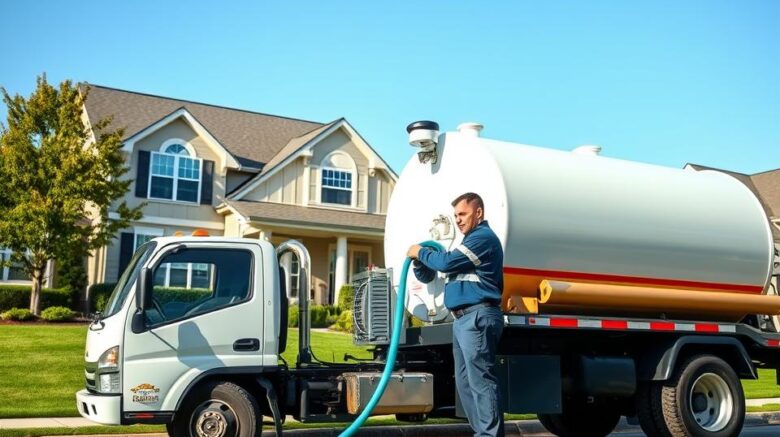Septic Tank Pumping Fees
Have you paused to consider about the true price of keeping your septic system current, or if you’re spending more than necessary? It’s critical for homeowners to understand the details of septic tank pumping prices. Generally, the price tag hovers around $420, though it can range significantly. This difference stems from factors like your tank’s volume and where you live – septic tank pumping services.
Regular maintenance of your septic tank wards off hefty repairs, underscoring the value of knowing service costs. This article will examine septic tank service pricing comprehensively. This will enable smart budgeting financially for your system’s care.
Important Takeaways
- Average septic tank pumping comes to about $420 USD.
- Prices can sit between $290 and $560 based on various variables.
- Regular upkeep heads off pricier repairs down the line.
- Most households require pumping every 3 to 5 years.
- Number of occupants and use can affect pumping frequency.
Understanding the Value of Septic Tank Pumping
Septic tank pumping is critical for a well‑functioning sewage system. It removes solids that, if ignored, lead to backups. Consistent pumping also avoids bad smells but also fends off high repair costs.
Neglecting septic tank maintenance can jeopardize our extensive reliance on these systems. Thankfully, affordable services minimize the risk of system failure. Regular upkeep lengthens your septic system’s life, helping maintain smooth operation.
Pricing for septic tank upkeep illustrates the value of proactive care. Maintenance detects problems before they escalate, dodging serious damage and steep repair bills. Regular pumping is a prudent move for homeowners to safeguard their asset and gain peace of mind.
Standard Fees for Septic Tank Pumping
Septic tank pumping typically comes between $250 and $600 in cost. Usually, homeowners will spend about $400 for this essential service. Price variations are due to elements like tank size, property location, and how often maintenance is done. Common tanks, around 1,000 gallons, usually cost between $225 and $400.
Homeowners should remember the necessity of setting aside funds every 3 to 5 years for septic tank cleaning. This scheduled care is based on the system load and size. It helps avert more serious, more expensive issues down the road, demonstrating to be both time and money‑efficient.

Factors Influencing Septic Tank Pumping Prices
A number of factors are crucial in establishing the price of septic tank pumping. Understanding these details helps homeowners to budget for these required services wisely.
The capacity is significant a lot. Higher‑capacity tanks demand more labor and time to empty, which results in higher fees. The accessibility to your tank also greatly affects the price. Tanks set far underground or in difficult locations demand more hours and specialized equipment from technicians, thus hiking the labor costs.
Costs can vary widely depending on where you live. This is due to shifts in local labor rates and disposal fees. For example, some areas impose higher charges for disposing of waste, affecting the final service cost. Moreover, tanks with heavy solid waste accumulation also attract additional fees—anywhere from $100 to $300. Plus, the more frequently a tank needs pumping—due to higher water usage—the higher the ongoing expenses.
Septic Tank Size and Its Impact on Cost
The capacity of your septic tank clearly influences the cost of its upkeep. Compact tanks, such as, those that can hold 750 gallons, typically have lower pumping costs, generally ranging from $175 to $300. On the other hand, larger tanks, capable of holding up to 1,750 gallons, may incur charges between $400 and $700. The majority of single‑family residences have tanks that hold between one thousand to 1,250 gallons, delivering a blend between size and efficiency.
Households with smaller tanks or higher numbers of occupants often need more frequent pumping services, which improves the overall expense. It’s important to schedule regular septic tank inspections in these situations. This makes sure the tank does not overflow or malfunction, which prevents additional costs. By understanding the connection between tank size and service fees, homeowners can reach knowledgeable choices regarding their septic systems and their upkeep requirements.
Regional Differences in Septic Tank Pumping Costs
Septic tank pumping costs can differ greatly based on region. In urban areas, the expenses are often higher due to local septic services experiencing increased overhead. For example, Minneapolis, MN residents may spend between $180 USD and $280 USD, while those in Portland, OR could see prices from $440 to $750.
The reasons behind these gaps are varied. They include regional expenses, demand for septic specialists, and regional regulations. In places where septic services are scarce, homeowners might incur higher charges due to the fewer choices. Moreover, strict regulations in some regions can push up the need for higher compliance fees, influencing the cost of services.
Knowing about these geographic cost variances is important for homeowners. It allows them to budget their septic maintenance budget more realistically. By recognizing local pricing, they can obtain quotes from specialists smartly, maintaining their septic system effectively without overspending.
Extra Expenses to Consider with Septic Tank Pumping
Homeowners often forget about various additional maintenance costs linked to septic tank pumping. The primary cost covers just the basic service, not covering other potential expenses. Understanding these can aid in preparing a comprehensive budget.
CCTV inspections, for instance, range between $250 USD to $500 USD. They offer a minimally disruptive look into the system’s condition. Additionally, filter maintenance, which if overlooked can cause system failures, represents another cost.
The spread for repairs can be broad, from $100 to $4,000 USD, according to the specific issues. This variability emphasizes the importance of factoring in additional maintenance costs for future budgeting.
Budgeting for Septic Tank Maintenance
When planning for septic tank upkeep, it’s important to adopt a all‑inclusive view. This covers multiple critical elements. Owing to variable factors, the cost of maintenance can change considerably. Because of this, proper financial planning is indispensable.
To ensure your system functions smoothly and to sidestep unforeseen bills, keep these timelines and services in mind:
- Scheduled pumping: This service is typically required every three to five years.
- Inspections: Plan for around $250 to $1,180 for inspections every three years.
- Potential repairs: Maintain a fund for surprise repairs, which can pop up unexpectedly.
Creating a regular maintenance calendar with a dependable septic service is key. By forecasting these expenses, homeowners can evade the large costs tied to neglect. This approach ensures the longevity and performance of their septic systems.
Typical Indicators That Your Septic Tank Needs Pumping
Remaining vigilant to your septic system’s condition is vital. Identify the initial clues that suggest your septic tank is due for pumping. Doing so can avoid serious damage and cut repair costs.
- Slow drains: Water that drains slowly in sinks, tubs, or toilets could signal your septic tank is overflowing.
- Unpleasant odors: Bad smells near the septic tank or in your yard are frequently urgent signs of a problem.
- Gurgling sounds: Unusual gurgling from your plumbing might show air is trapped because of a blockage.
- Wet spots: Standing water or lush grass patches near the drain field signal waste seepage from the tank.
- Dark green grass: Grass that is darker and appears robust around the drain field may indicate leakage of nutrients, signaling an issue.
Routine checks by septic system experts can ensure your tank is in healthy condition. Using skilled septic technicians for maintenance avoids these issues, guaranteeing your system’s longevity.
Benefits of Regular Septic Tank Inspections
Regular inspections are key to maintaining your septic system in prime shape. They spot potential problems before they become costly repairs. By bringing in professionals for these checks, every part of your system undergoes a thorough assessment.
The process looks at various parts of your system, including waste levels and the drain field’s condition. It verifies that critical parts, like baffles, function as they should. Spotting issues early helps prevent harmful overflows and safeguards the environment, aiding both your home and the wider community.
Having your septic tank checked every three years can save you a lot of money. It stops bigger issues from developing due to neglect. This not only lowers on repair costs but also secures your peace of mind.
| Inspection Aspect | Importance |
|---|---|
| Waste Level Assessment | Prevents overflow and backups |
| Drain Field Evaluation | Identifies saturation and function |
| Component Functionality Check | Ensures proper system operation |
| Early Problem Detection | Saves on repair costs |
Tactics to Save on Septic Tank Pumping Prices
Homeowners aiming to lower septic tank pumping costs have a few strategic options. Arranging group services with neighbors is one smart method. This involves coordinating with others nearby to schedule services as a group, potentially geting group discounts. It’s a way to strengthen community bonds while trimming expenses more efficiently.
Another helpful approach is to enroll in maintenance plans with septic service providers. These plans often offer discounted prices for routine check‑ups and pumpings, ensuring septic systems operating properly at a lower cost. Homeowners are advised to ask about these plans when contacting service companies.
Making the septic tank easily available can also help reduce pumping expenses. Clear accessibility means there’s less chance of extra labor charges. It’s smart to keep the area around the tank clear of clutter, permitting straightforward servicing.
Embracing certain habits helps in lengthening the time between pumpings as well. Reducing water usage and curbing garbage disposal use are key practices. These actions can significantly boost septic system health, lowering the need for regular maintenance. By implementing these habits, homeowners can successfully reduce their septic tank pumping costs, safeguarding their finances and systems.
Final Remarks
Guaranteeing routine septic tank pumping is key for homeowners who want to keep their waste management system efficient and in top shape. Being informed about the costs involved permits smart budgeting. This way, you can get cost‑effective septic services without hurting your system’s performance.
Taking a proactive approach to maintenance is highly advantageous. By noticing clues that signal the need for pumping, you can avoid expensive repairs and prolong your system’s lifespan. Such actions not only improve your home’s functionality but also deliver you peace of mind.
To wrap up, maintaining routine inspections and timely septic tank pumping is critical for efficient home maintenance. By giving importance to proper planning and choosing affordable septic service, you’ll ensure your septic system remains operational and reliable for many years.
